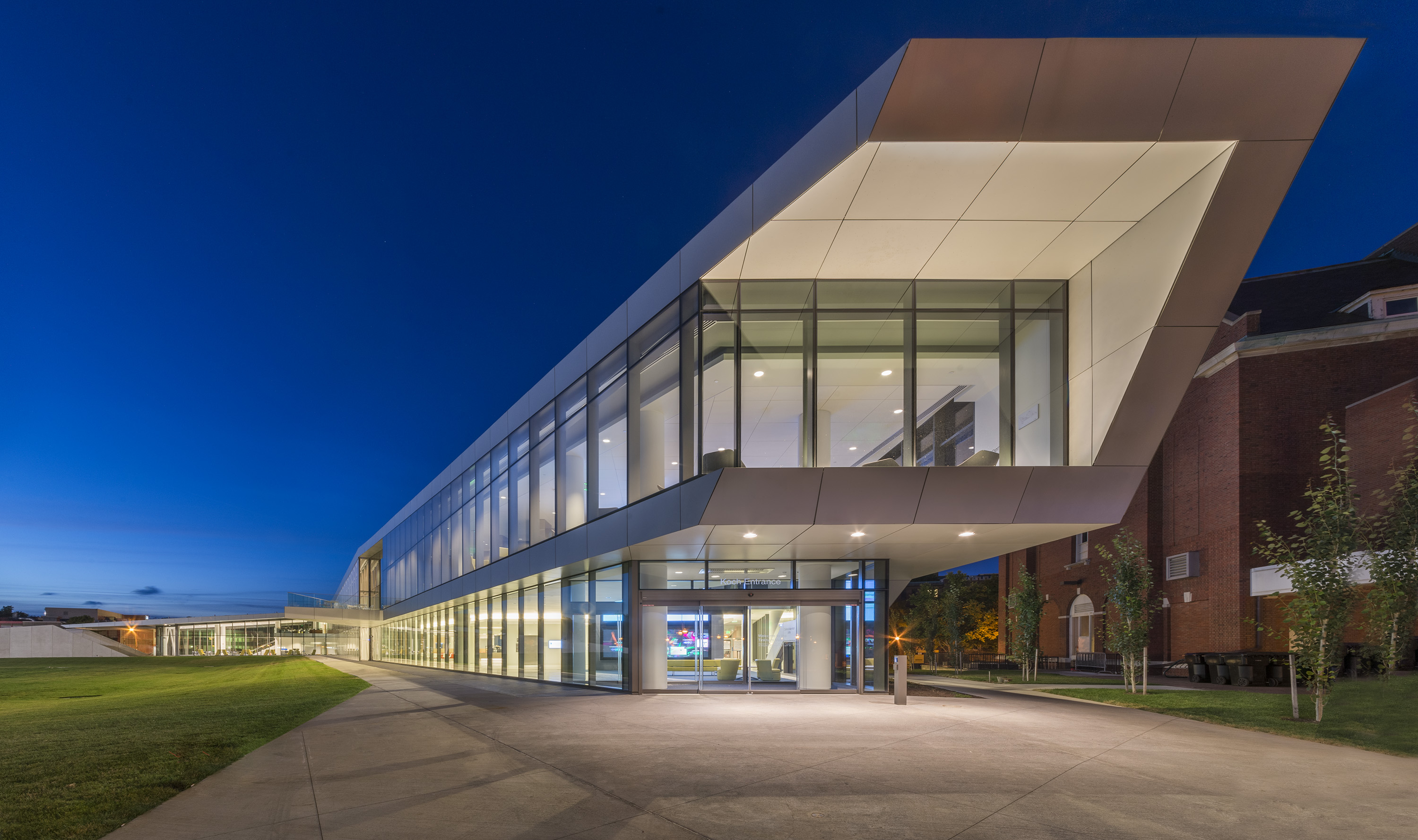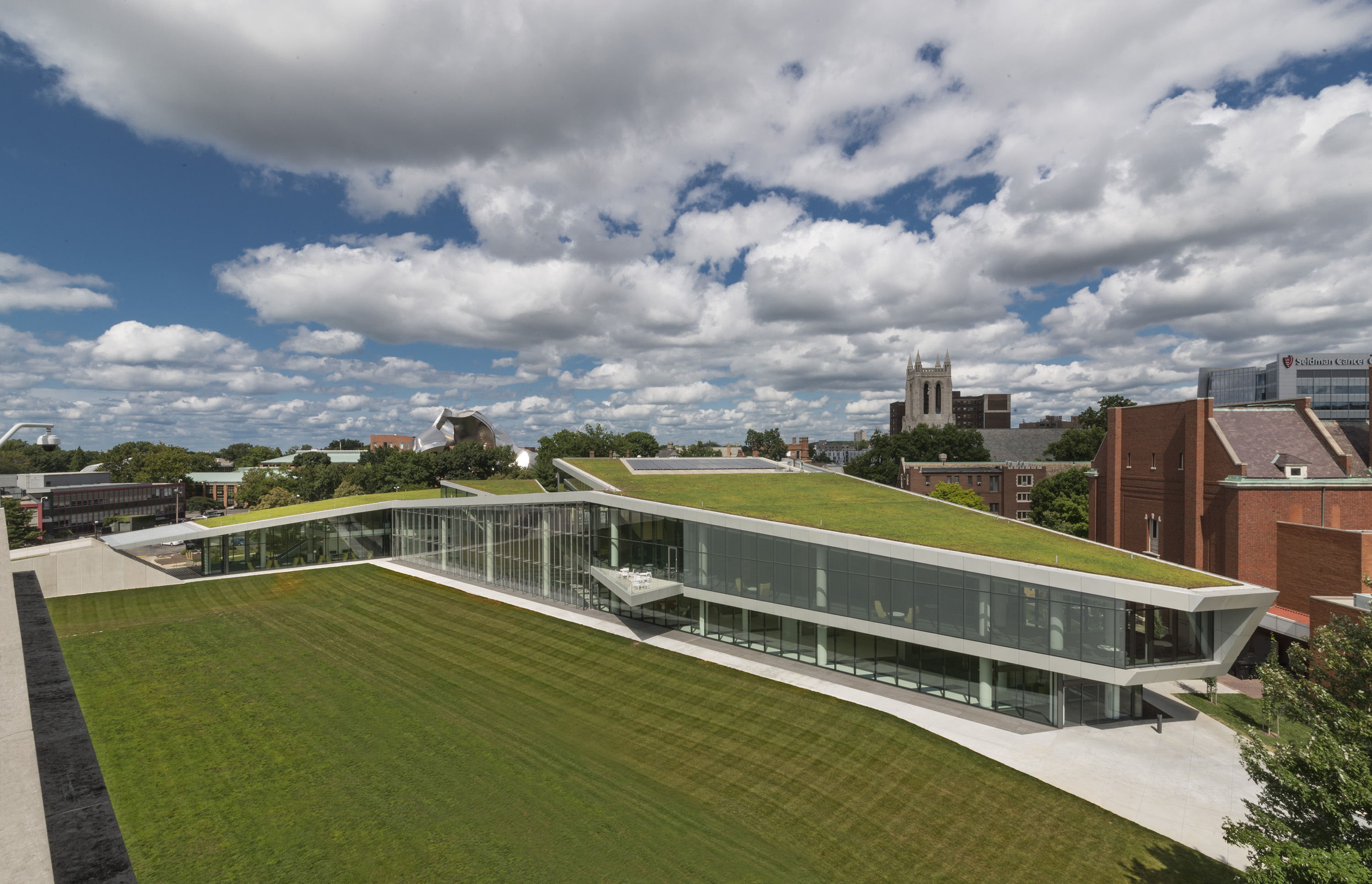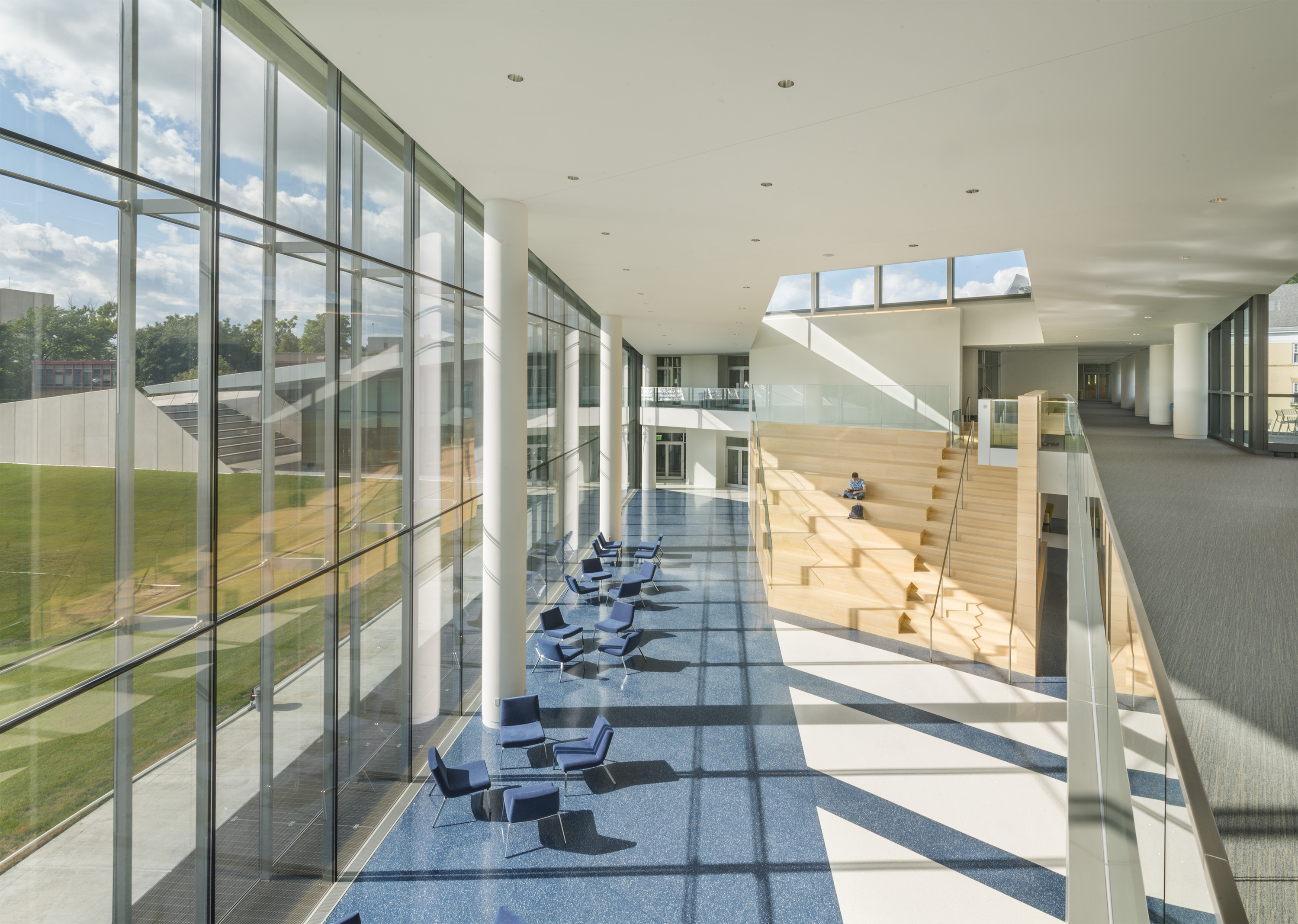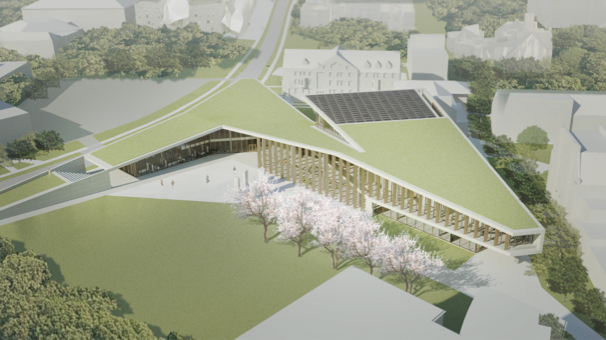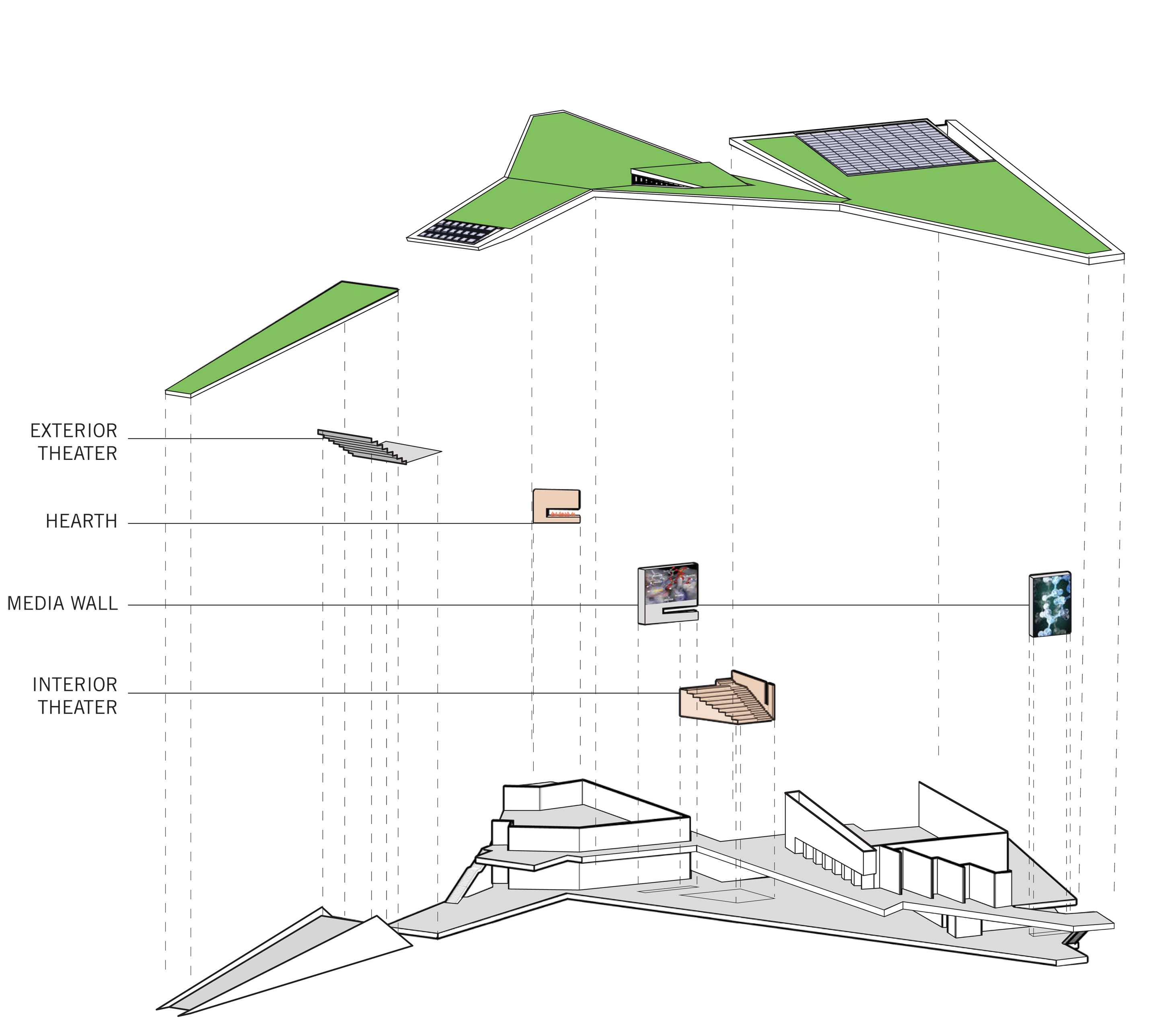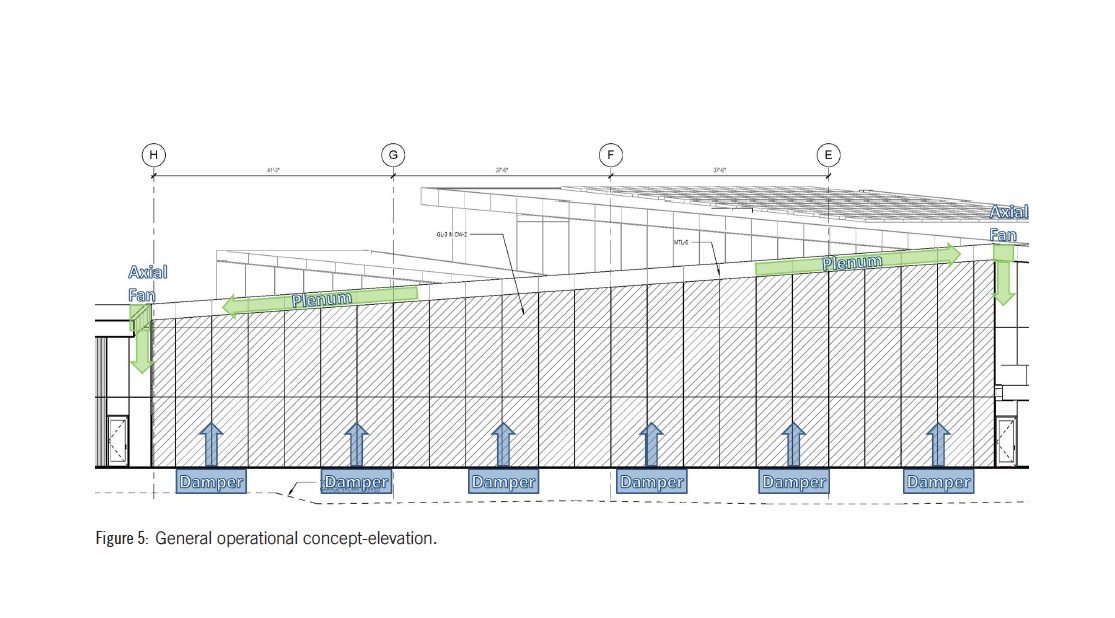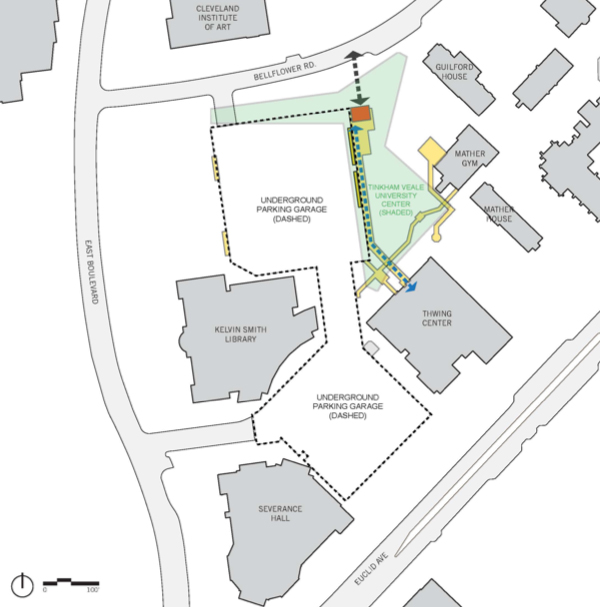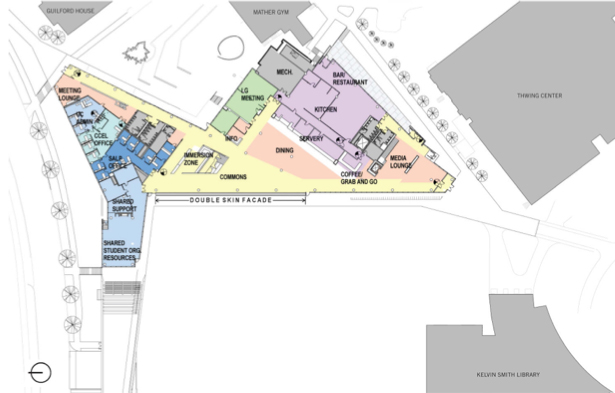The opening of the new two-story Tinkham Veale University Center, designed by global architecture and design firm Perkins+Will, brings together the two historic campuses of Cleveland’s Case Western Reserve University in a sustainably-designed university center.
The 89,000 sf building combines public spaces, quiet study areas, student organization offices, and a variety of spaces for community functions—all to foster greater interaction and collaboration among students, faculty, staff and community.
With its sloping grass-covered green roof, the two-story building is at the intersection of the two historic original Western Reserve University and Case Institute of Technology campuses, and includes a pass-through walkway that extends through the building connecting the campuses.
The Perkins+Will project team, led by its Chicago and Atlanta offices, designed a center with defined social/cultural, meeting/event, and food/beverage areas with intersecting, public spaces to encourage socializing, collaborating, studying and relaxing.
The campus is within Cleveland’s University Circle district, which includes various cultural institutions such as the Cleveland Museum of Art and Severance Hall, home of the Cleveland Orchestra. The siting of the building imposed a variety of constraints, required particular design sensitivities, and sparked a number of innovations. It is next to an underground parking garage, which would not support the weight of a large building. The space also is surrounded by four other campus buildings, the Arts Courtyard, a playing field and a public street.
The shape of the building addresses these constraints by stretching horizontally in three directions. The center frames Freiberger Field, a popular student gathering place, which sits atop the parking garage, and provides greater definition to two other outdoor spaces, the Arts Courtyard and the Mather Courtyard.
“We turned a challenging space into an asset,” said Ralph Johnson, Perkins+Will Global Design Director and Design Principal on the project. “We celebrated and defined these open spaces."
The university was also keenly interested in a building featuring openness, transparency and interactivity. A key decision to create greater interaction led to placing an outdoor walkway that connected the North Campus and the Case Quad into the new center.
"The building brings together various areas of the campus into a central social space for students," added Johnson. "The design respects the context and the constraints of the site it is on and, with the pass-through walkway, provides a major circulation path that energizes the interior of the building."
"In fact," said Stephen Campbell, the university’s Vice President for Campus Planning and Facilities Management, "we sought input from students in the planning and design. We expect them to make the center their own."
The building, open 24 hours a day, seven days a week, is designed to provide for informal and formal gatherings for undergraduates, graduates, faculty, staff, and the community. It is unlike any building that currently exists on campus.
"We were able to create a highly transparent building with public and private spaces that promote interaction among students, faculty and staff throughout their daily campus experience," said Mark Jolicoeur, Perkins+Will Managing Principal on the center.
Another key design feature to the center is a two-story, west-facing double-glass wall that required an innovative engineering system to address solar heat-gain generated by late afternoon sunlight. To reduce energy use and better control the interior environment, the team used fans that pull air to cool the space between the glass walls at high temperatures, while rooftop sensors trigger roller shades to be lowered when the sun is creating glare in the Commons.
During cold winter months, the glass walls allow warmer air to build up. With the glass wall situated above a section of the parking garage containing an air shaft, the design team also had to calculate how to maintain proper air circulation into, and out of, the garage.
The new center is a model of environmental stewardship through its design, construction, and operation. The building is designed to meet or exceed LEED Silver standards.
Perkins+Will brought an interdisciplinary approach to the project, involving Architecture, Interiors, Branded Environments, and Higher Education expertise.
Perkins+Will is a leading designer of higher education buildings, and expects to complete eight student center projects in 2014.
"Case Western Reserve is probably the most progressive expression of the modern student center," said B. Jeffrey Stebar, Planning Principal and a national expert on designing campus centers. "More and more student learning will take place in environments like this center—spaces where students and faculty and the campus community can meet and explore outside traditional and formal learning spaces."
Local architecture support in Cleveland was provided by CBLH Design. Renderings courtesy of Perkins+Will, Case Western Reserve University.
Level 1 plan
Related Stories
| Aug 11, 2010
Dual physics buildings aim for LEED Silver
Two new physics buildings providing 197,000 sf of teaching, study, and office space are opening at Texas A&M University. The $82.5-million George P. Mitchell '40 Physics Building and the George P. and Cynthia Woods Mitchell Institute for Fundamental Physics and Astronomy offer new research laboratories, graduate and undergraduate lounges, offices, a 468-seat lecture hall, and a 180-seat aud...
| Aug 11, 2010
Recreation facility scores with sustainable features
A new $79.1 million health and learning center is under construction on the Northern Arizona University campus in Flagstaff. The 270,000-sf facility will house recreation space, classrooms, health and counseling services, and the Lumberjack Stadium for track and soccer teams. Designed by the Phoenix office of OWP/P Cannon Design with Mortenson Construction as CM, the project is aiming for LEED ...
| Aug 11, 2010
University building gets revamped, reused
KSS Architects of Philadelphia is designing the addition and renovation to SUNY Cortland's Studio West, a 43,000-sf metal panel and brick building dating to 1948. The 20,000-sf, two-story addition will become the Professional Studies Building, housing the consolidated departments of Recreation, Parks, and Leisure Studies; Communications Disorders and Sciences; and Kinesiology and Sports Managem...
| Aug 11, 2010
And the world's tallest building is…
At more than 2,600 feet high, the Burj Dubai (right) can still lay claim to the title of world's tallest building—although like all other super-tall buildings, its exact height will have to be recalculated now that the Council on Tall Buildings and Urban Habitat (CTBUH) announced a change to its height criteria.
| Aug 11, 2010
Project is music to school's ears
Florida Gulf Coast University is building a $7.55 million Fine Arts Building on its campus near Ft. Myers, Fla. The 25,000-sf building—the first project in the school's plan for an entire music complex—will house the music program of the College of Arts and Sciences. The facility includes a 200-seat recital hall, rehearsal hall, music labs, studio rooms, and administration offices.
| Aug 11, 2010
BU students move into high-rise dorm
Boston University’s newest residential building rises 26 stories above the Charles River. Part of the school’s 10-acre John Hancock Student Village, the 396,000-sf tower houses 962 students and has three apartments for faculty use. The tower also has a large multipurpose room on the top floor.
| Aug 11, 2010
Expansion of chemistry facility no experiment
A September ground breaking at Wayne State University in Detroit puts the school’s A. Paul Schaap Chemistry Building and Lecture Hall on track for a December 2010 completion. The $37 million, 96,000-sf facility is the second phase of a two-phase project to expand and renovate the existing chemistry building.
| Aug 11, 2010
Community college’s hillside learning center
The Earl E. and Dorothy J. Dellinger Learning Resource Center at Southwest Virginia Community College in Richlands, Va., is the centerpiece of this mountainside school. Designed by Arlington, Va.-based The Lukmire Partnership, the 50,000-sf, two-story building connects the upper and lower campuses, which are separated by a 70-foot vertical grade change.
| Aug 11, 2010
Broadway-style theater headed to Kentucky
One of Kentucky's largest performing arts venues should open in 2011—that's when construction is expected to wrap up on Eastern Kentucky University's Business & Technology Center for Performing Arts. The 93,000-sf Broadway-caliber theater will seat 2,000 audience members and have a 60×24-foot stage proscenium and a fly loft.
| Aug 11, 2010
Polshek unveils design for University of North Texas business building
New York City-based architect Polshek Partnership unveiled its design scheme for the $70 million Business Leadership Building at the University of North Texas in Denton. Designed to provide UNT’s 5,600-plus business majors with a state-of-the-art learning environment, the 180,000-sf facility will include an open atrium, an internet café, and numerous study and tutoring rooms—al...


